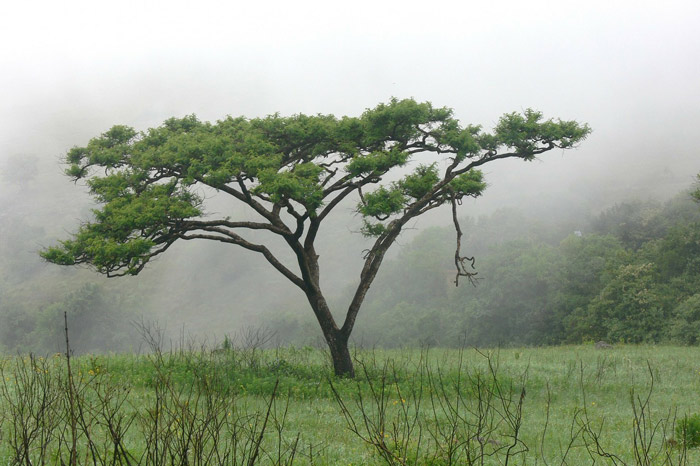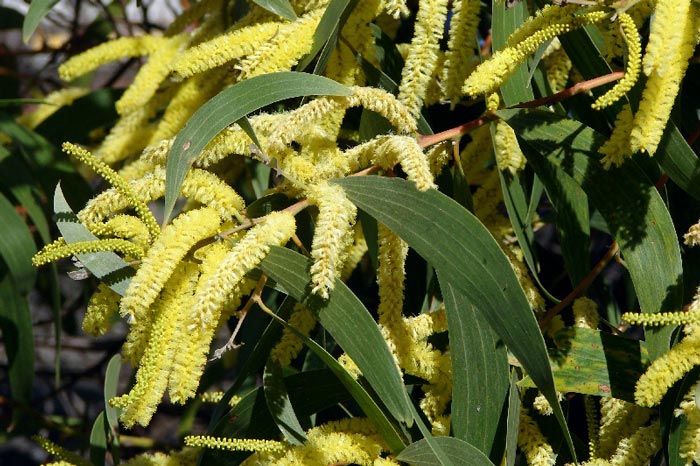
Acacia (genus acacia) contains a large number of species of shrubs and trees (over 1000).
This makes it the largest genus in the pea family (Fabaceae). It is also widespread across Asia, Australia, Africa, and the Americas.
Acacias are native to tropical regions of the world. In Africa, they are famous landmarks on the savanna and veld. Acacia trees are multipurpose. They are widely used in forestry, agroforestry, and restoration of degraded lands.
What Do Acacia Trees Look Like?

There are common characteristics found in acacia species despite their diversity. One of them is the distinctive seed pods that acacias, peas, and other legumes grow.
Their sharp thorns are easy to spot and protect the leaves from herbivorous animals. These thorns work as a defense mechanism for acacias grown in dry environments. Many desert plants have similar thorns on them.
Acacia trees have leaves that are small and oval in shape. This gives them the appearance of a double-sided comb. They are also called pinnate leaves.

In areas with little or no rainfall, it is paramount for an acacia tree to retain water in its leaves.
Before we get into all the amazing qualities of acacia wood, here are a few reasons to grow the tree:
- Can grow in almost any type of soil
- Are fast-growing
- Rarely need pesticides
- Do not need fertilizer
To top it off, some Acacia species grow in cold weather. They also make excellent garden plants as they range in size. You can plant low growing species, bigger shrubs, and shade trees.
Examples of Acacia Trees for Your Garden
Acacias are quite attractive plants and below are a few examples to choose from for your garden.
One beautiful quality is the flowering acacia in full bloom that has a fuzzy appearance. Take a look below:
Acacia Pycnantha – Golden Wattle

This species of acacia is a shrub or small tree native to Australia. It’s actually considered Australia’s national flower!
In later winter and spring, acacia produces bright yellow blooms. These are followed by long seed pods. It grows to a height of 8m (26ft) and has flattened leaf stalks (phyllodes) instead of true leaves.
These trees are used in many countries for soil improvement and dune stabilization.
The acacia tree is also valued for the tannin found in its bark. It produces the highest tanning yield of all acacias. You can start harvesting tannin from seven to ten-year-old trees.
Because they are quite small, there’s a limit on their commercial distribution. They hold great value as fuelwood.
Its scented yellow flowers have found use in honey production and perfume making. Due to its similarity to a mimosa tree, acacia is grown for cut flower trading and often sold as “mimosa”.
Senegalia Senegal – Gum Arabic

This species of acacia is native to Sudan in Africa and also known as acacia Senegal. It is well known for the gum arabic it yields. This substance is used in pharmaceuticals, adhesives, confections, inks, and other products.
The acacia Senegal tree can withstand extreme climatic conditions. Moreover, it’s adaptable to environmental changes. It can grow to a height of 5 -12 meters with a trunk of up to 30 cm in diameter.
An organic gardener could reap economic benefits from:
- The gum arabic
- The roots and bark of the tree that can be used to make rope and cords
- The wood from the tree which is sturdy enough to make tool handles, as well as firewood
Acacia Mearnsii – Black Wattle

This is a fast-growing, spreading shrub that can reach a height of 10m (33ft). In Australia, acacia plays an important role in the ecosystem. It acts as a binding element in the erosion-prone soil often affected by bushfires.
As such, acacia fixes the atmospheric nitrogen in the soil like other leguminous plants. Its extensive root systems contain bacterial nodules which benefit other woodland species.
It is vital in the natural regeneration of bushland in Australia after wildfires. Similar to the other species of acacia, this type has strong hardwood. It’s useful for sourcing fuelwood, fencing posts and tool handles.
It is cultivated in temperate regions globally as any agroforestry and ornamental tree.
On farmland, Acacia mearnsii is a weed and should be avoided in intercropping systems. Yes, despite its nitrogen addition it does compete for light and nutrients with other crops.
Why not use our grampa’s weeder to get rid of them?

$35.99
Buy Now
Here’s an idea, let acacia fill up your landscape as an ornamental centerpiece in a large yard. Its lovely feathery foliage and winter flowers are a spectacle to behold.
One way to control the spread of acacia trees is to harvest young acacia saplings. You’ll get both trellises for climbing beans and firewood.
A great substitute for trellises is our foldable tomato cages that come in a set of three.
Faidherbia Albida

If you live in a dryland region, planting this acacia can benefit your garden. Countries such as Niger, for example, use this acacia tree to reclaim the desert towards the edge of Western Africa.
When it comes to trees, acacia has the power to make land fit for agriculture again. Don’t believe it? Here’s how.
The Faidherbia albida has a reversed phenology. This allows its leaves to stay green throughout the dry season and then shed in the wet season.
This makes it suitable for agroforestry because it provides shade from the soil which conserves its moisture. It also protects crops from excessive sunlight.
It has narrow leaves that allow sunlight to pass and reach the crops for photosynthesis. The acacia leaves fall in the rainy season and decompose due to the availability of moisture. Then their organic matter is taken in by the soil for plants.
There’s no limit to the host benefits associated with this tree. An organic gardener would enjoy the following opportunities with this acacia tree:
- Beekeeping
- Source of gum arabic
- Medicinal uses
- Nitrogen fixation
- Nesting sites for birds (for birdwatch lovers)
Acacia Tree Sustainability
Acacia’s durability, hardness, and strength make it scratch-resistant. It is a practical choice for furniture because it is less prone to wear and tear compared to other woods.
It is resistant to insects, moisture, and fire without extra aid from treatments. This marks it as an easy tree to contain.
If you are after filters of a fragrant, homey touch then an acacia tree will do the trick! Why not add a homey touch to all the furniture you make from it?
You can use wood from an acacia tree for flooring, furniture, and so much more.
Grow Acacia Trees and More With Clean Air Gardening
If you’ve been on the hunt for eco-friendly, sustainable wood, look no further. The tips above are a great start for gardeners intrigued by such versatile trees.
Is planting species of acacia trees in your garden worth it? Absolutely, yes! As long as you’ve got a proper guide. Luckily, that’s what we are here for.
Clean Air Gardening aims to support all your sustainable gardening efforts. For over 20 years we’ve helped many in their organic gardening journeys:
| I ordered 2 composters from them and the service was prompt and complete. Nothing to complain about! |
| I ordered a nice hori hori from them. Their prices were comparable to other prices I found on the Web and their shipping was not inflated. I received it quickly, particularly considering it went from Texas to Wisconsin. They also had a nice selection of products. All in all a very nice buying experience. |
| Purchased a rain barrel and garden gourmet composter from this company. Quick shipping, reasonable prices. Would do business with again. |
| Ordered a rain barrel which was very nice and just what I wanted. Shippment was very quick. A good product and a very fair price. |
| I ordered a lawn mower on a Saturday, and received it on Wednesday! They have lots of great stuff to drool over and had plenty of info about push reel mowers which I had never used before. Quality mower (Brill) and shipped fast! |
Source: davesgarden.com
Trust us to provide you with all you need to benefit your garden, local community, and the earth.
Featured image: wikimedia

